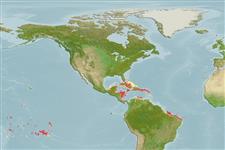>
Kurtiformes (Nurseryfishes, cardinalfishes.) >
Apogonidae (Cardinalfishes) > Apogoninae
Etymology: Apogon: Greek, a = without + Greek pogon = chin, beard (Ref. 45335); robbyi: Named after Dr. C. Richard ('Robby') Robins.
Eponymy: Dr Charles Richard ‘Dick’ Robins (1928–2020) (See Robins, CH & CR) (Ref. 128868), visit book page.
Environment: milieu / climate zone / depth range / distribution range
Ökologie
seewasser demersal; tiefenbereich 1 - 30 m (Ref. 26883). Tropical
Western Central Atlantic: Belize, Nicaragua and Jamaica.
Size / Gewicht / Alter
Maturity: Lm ? range ? - ? cm
Max length : 3.6 cm SL Männchen/unbestimmt; (Ref. 26883)
Found in a wide variety of habitats, including grass flats, partially open sand bottoms around the bases of finger and globose sponges, tentacles of anemones, inside live conch shells, and around coral reefs and high relief structures such as artificial reefs (Ref. 26883). Presumably, striped cardinalfish leaves its daytime hovering places to forage over grass and sand flats at night (Ref. 26883).
Life cycle and mating behavior
Geschlechtsreife | Fortpflanzung | Ablaichen | Eier | Fecundity | Larven
Mouthbrooders (Ref. 240). Distinct pairing during courtship and spawning (Ref. 205).
Gilbert, C.R. and J.C. Tyler, 1997. Apogon robbyi, a new cardinalfish (Perciformes: Apogonidae) from the Caribbean Sea. Bull. Mar. Sci. 60(3):764-781. (Ref. 26883)
IUCN Rote Liste Status (Ref. 130435: Version 2024-1)
Bedrohung für Menschen
Harmless
Nutzung durch Menschen
Fischereien: nicht kommerziell
Tools
Zusatzinformationen
Download XML
Internet Quellen
Estimates based on models
Preferred temperature (Ref.
123201): 27.2 - 28.2, mean 27.8 °C (based on 338 cells).
Phylogenetic diversity index (Ref.
82804): PD
50 = 0.5000 [Uniqueness, from 0.5 = low to 2.0 = high].
Bayesian length-weight: a=0.01445 (0.00680 - 0.03071), b=3.07 (2.89 - 3.25), in cm total length, based on LWR estimates for this (Sub)family-body shape (Ref.
93245).
Trophic level (Ref.
69278): 3.3 ±0.4 se; based on size and trophs of closest relatives
Widerstandsfähigkeit (Ref.
120179): hoch, Verdopplung der Population dauert weniger als 15 Monate. (Preliminary K or Fecundity.).
Fishing Vulnerability (Ref.
59153): Low vulnerability (10 of 100).
